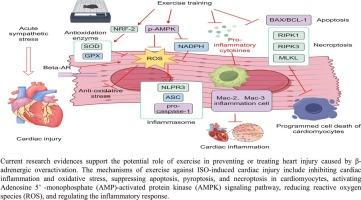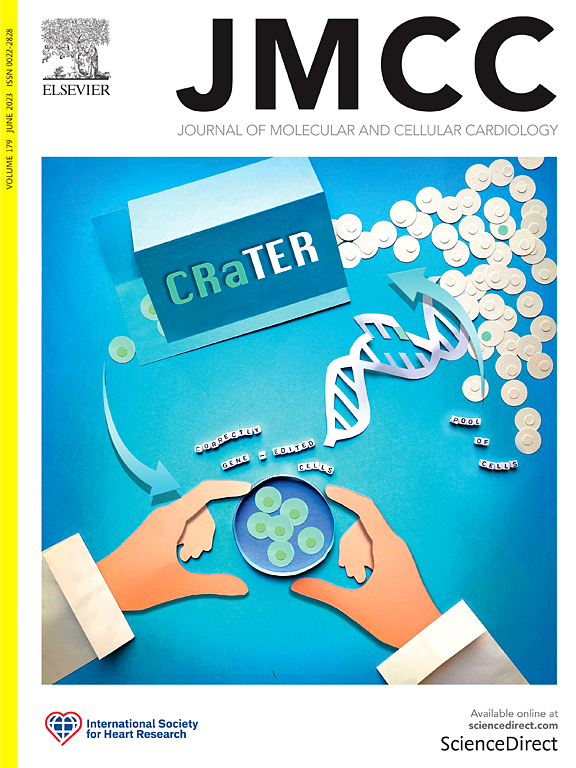运动减轻β -肾上腺素能过度激活引起的心脏损伤的动物模型和机制。
IF 4.7
2区 医学
Q1 CARDIAC & CARDIOVASCULAR SYSTEMS
引用次数: 0
摘要
急性交感应激引起心脏β-肾上腺素能受体(β-AR)的过度激活,是心脏病发生的关键病理因素。异丙肾上腺素(isoterenol, ISO)是一种非选择性β-AR激动剂,用于建立病理性心脏重构的实验动物模型,模拟急性交感应激性心脏损伤。目前的研究证据支持运动在预防或治疗β-肾上腺素能过度激活引起的心脏损伤中的潜在作用。运动对抗iso诱导的心脏损伤的机制包括抑制心脏炎症和氧化应激,抑制心肌细胞凋亡、焦亡和坏死,激活腺苷5′-单磷酸腺苷(AMP)活化蛋白激酶(AMPK)信号通路,减少活性氧(ROS)调节炎症反应。尽管运动对减轻iso引起的心脏损伤有保护作用,但需要进一步研究运动强度和运动时间的最佳组合。此外,还需要进行比较研究,评估不同运动类型的保护作用,探讨运动诱导的保护作用与ISO剂量的关系,揭示运动对ISO诱导的心脏损伤保护作用的新机制。本研究将提高我们对运动对β-肾上腺素能负荷引起的心脏损伤的保护机制的认识,并为研究运动对β-肾上腺素能负荷引起的心脏损伤的作用奠定更坚实的基础。本文章由计算机程序翻译,如有差异,请以英文原文为准。

Animal models and mechanisms of exercise in attenuating cardiac injury induced by beta-adrenergic hyperactivation
Acute sympathetic stress, which causes hyperactivation of β-adrenergic receptors (β-AR) in the heart, is a key pathological factor in the development of cardiac disease. Isoproterenol (ISO) is a non-selective β-AR agonist, which was utilized to develop an experimental animal model of pathological cardiac remodeling, simulating the acute sympathetic stress-induced cardiac injury. Current research evidences support the potential role of exercise in preventing or treating heart injury caused by β-adrenergic overactivation. The mechanisms of exercise against ISO-induced cardiac injury include of inhibiting cardiac inflammation and oxidative stress, suppressing apoptosis, pyroptosis, and necroptosis in cardiomyocytes, activating Adenosine 5′ -monophosphate (AMP)-activated protein kinase (AMPK) signaling pathway, reducing reactive oxygen species (ROS) to regulate the inflammatory response. Despite the protective effects of exercise in attenuating ISO-induced cardiac injury, further studies are necessary to explore the optimal combination of exercise intensity and duration. Additionally, comparative research is required to evaluate the protective effects of different exercise types, investigate the relationship between exercise-induced protection and ISO dosage, and reveal new mechanism underlying the protective effects of exercise against ISO-induced heart injury. This study will improve our understanding of the mechanisms by which exercise protects against cardiac injury induced by β-adrenergic overload, and establish a stronger foundation for studying the effects of exercise against β-adrenergic overload-induced cardiac injury.
求助全文
通过发布文献求助,成功后即可免费获取论文全文。
去求助
来源期刊
CiteScore
10.70
自引率
0.00%
发文量
171
审稿时长
42 days
期刊介绍:
The Journal of Molecular and Cellular Cardiology publishes work advancing knowledge of the mechanisms responsible for both normal and diseased cardiovascular function. To this end papers are published in all relevant areas. These include (but are not limited to): structural biology; genetics; proteomics; morphology; stem cells; molecular biology; metabolism; biophysics; bioengineering; computational modeling and systems analysis; electrophysiology; pharmacology and physiology. Papers are encouraged with both basic and translational approaches. The journal is directed not only to basic scientists but also to clinical cardiologists who wish to follow the rapidly advancing frontiers of basic knowledge of the heart and circulation.

 求助内容:
求助内容: 应助结果提醒方式:
应助结果提醒方式:


